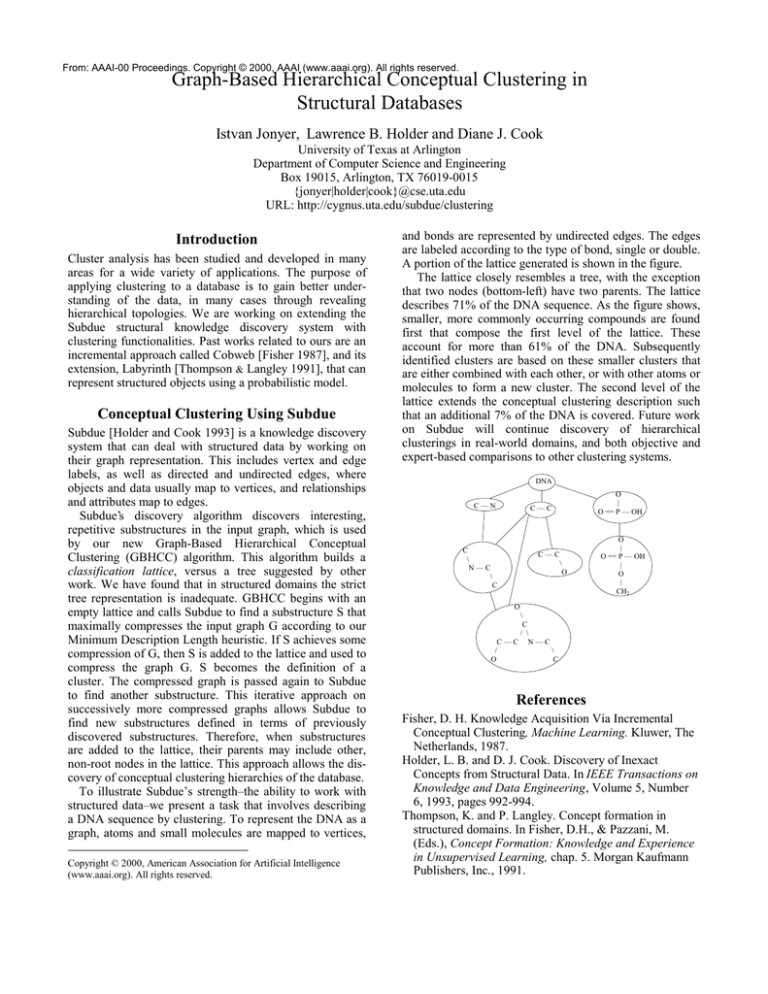
From: AAAI-00 Proceedings. Copyright © 2000, AAAI (www.aaai.org). All rights reserved.
Graph-Based Hierarchical Conceptual Clustering in
Structural Databases
Istvan Jonyer, Lawrence B. Holder and Diane J. Cook
University of Texas at Arlington
Department of Computer Science and Engineering
Box 19015, Arlington, TX 76019-0015
{jonyer|holder|cook}@cse.uta.edu
URL: http://cygnus.uta.edu/subdue/clustering
Introduction
Cluster analysis has been studied and developed in many
areas for a wide variety of applications. The purpose of
applying clustering to a database is to gain better understanding of the data, in many cases through revealing
hierarchical topologies. We are working on extending the
Subdue structural knowledge discovery system with
clustering functionalities. Past works related to ours are an
incremental approach called Cobweb [Fisher 1987], and its
extension, Labyrinth [Thompson & Langley 1991], that can
represent structured objects using a probabilistic model.
Conceptual Clustering Using Subdue
Subdue [Holder and Cook 1993] is a knowledge discovery
system that can deal with structured data by working on
their graph representation. This includes vertex and edge
labels, as well as directed and undirected edges, where
objects and data usually map to vertices, and relationships
and attributes map to edges.
Subdue’s discovery algorithm discovers interesting,
repetitive substructures in the input graph, which is used
by our new Graph-Based Hierarchical Conceptual
Clustering (GBHCC) algorithm. This algorithm builds a
classification lattice, versus a tree suggested by other
work. We have found that in structured domains the strict
tree representation is inadequate. GBHCC begins with an
empty lattice and calls Subdue to find a substructure S that
maximally compresses the input graph G according to our
Minimum Description Length heuristic. If S achieves some
compression of G, then S is added to the lattice and used to
compress the graph G. S becomes the definition of a
cluster. The compressed graph is passed again to Subdue
to find another substructure. This iterative approach on
successively more compressed graphs allows Subdue to
find new substructures defined in terms of previously
discovered substructures. Therefore, when substructures
are added to the lattice, their parents may include other,
non-root nodes in the lattice. This approach allows the discovery of conceptual clustering hierarchies of the database.
To illustrate Subdue’s strength–the ability to work with
structured data–we present a task that involves describing
a DNA sequence by clustering. To represent the DNA as a
graph, atoms and small molecules are mapped to vertices,
Copyright © 2000, American Association for Artificial Intelligence
(www.aaai.org). All rights reserved.
and bonds are represented by undirected edges. The edges
are labeled according to the type of bond, single or double.
A portion of the lattice generated is shown in the figure.
The lattice closely resembles a tree, with the exception
that two nodes (bottom-left) have two parents. The lattice
describes 71% of the DNA sequence. As the figure shows,
smaller, more commonly occurring compounds are found
first that compose the first level of the lattice. These
account for more than 61% of the DNA. Subsequently
identified clusters are based on these smaller clusters that
are either combined with each other, or with other atoms or
molecules to form a new cluster. The second level of the
lattice extends the conceptual clustering description such
that an additional 7% of the DNA is covered. Future work
on Subdue will continue discovery of hierarchical
clusterings in real-world domains, and both objective and
expert-based comparisons to other clustering systems.
DNA
C—N
O
|
O == P — OH
C—C
C
\
N—C
\
C
C—C
\
O
O
|
O == P — OH
|
O
|
CH2
O
\
C
/ \
C—C N—C
/
\
O
C
References
Fisher, D. H. Knowledge Acquisition Via Incremental
Conceptual Clustering, Machine Learning. Kluwer, The
Netherlands, 1987.
Holder, L. B. and D. J. Cook. Discovery of Inexact
Concepts from Structural Data. In IEEE Transactions on
Knowledge and Data Engineering, Volume 5, Number
6, 1993, pages 992-994.
Thompson, K. and P. Langley. Concept formation in
structured domains. In Fisher, D.H., & Pazzani, M.
(Eds.), Concept Formation: Knowledge and Experience
in Unsupervised Learning, chap. 5. Morgan Kaufmann
Publishers, Inc., 1991.









